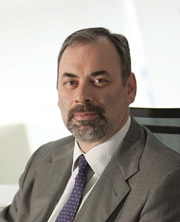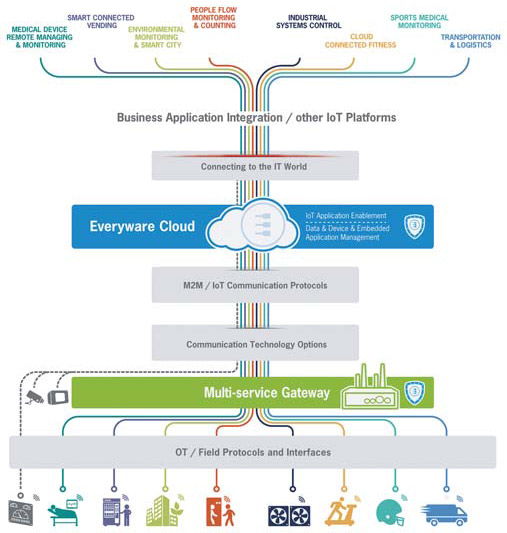IT infrastructure challenges are changing as a result of the rapid growth of the IoT. Various developments are enabling more effective operational technology (OT) integration as well as easier development, deployment and usage of innovative solutions deployed in the field. Roberto Siagri, the chief executive of Eurotech, talks to Bob Emmerson about the company’s plans in this expanded market
IoT Now: What additional benefits will seamless integration with enterprise computing bring to the market?
Roberto Siagri: That question goes to the heart of the matter. It will deliver two significant benefits. One is by facilitating digital transformation, which is set to impact on almost all aspects of our society. The other is that it will be disruptive. This is a benefit because it will lead to the development of brand new business models, models that open up new ways of thinking and of doing things. Right now we’re seeing too much old stuff being dressed up in new colours and being hyped to the hilt. However, the integration process itself should not be disruptive. Enterprises have made significant investments in IT systems and technologies, therefore adding IoT capabilities has to be done efficiently and in a way that maximises those investments.
We need new ways to be taken in order to make IoT a core component of digital transformation, which is reshaping virtually every aspect of business and our experience as customers. Enabling IoT by integrating the world of OT and the world of IT in seamless and non-intrusive ways is a key requirement.
IoT Now: What needs to happen in order to enable that transition?
RS: Lots of things are needed and they are happening. Enterprise computing operates in an efficient, powerful, IT-centric environment. In order to enable seamless integration we need to re-architect the underlying OT infrastructure. That entails using computational power at the edge in scenarios where it makes sense. Chipsets pack a lot of processing power and they are also getting smaller and cheaper, which means that it’s cost effective to embed multi-core chips sets in intelligent gateways where they handle complex tasks like real-time analytics at the local level. This capability is provided by third party software embedded in our gateways and it’s enabled and managed through our IoT middleware and our IoT integration platform. This approach means that there is no lock-in to a particular data analytics vendor.

It’s hard to overstate the importance of open source and industry standards. Also the fact that this is an ecosystem play: there is no one size fits all; no company has all the requisite knowhow and experience. Re-architecting the infrastructure should enable fast delivery of data from the field and it should be flexible, businesses need to be prepared for changes that simply can’t be anticipated. The architecture should enable access to data from devices across applications, build relationships between data sources and take action in one area based on data from another and last, but by no means least, the architecture should be agile and enable the creation of customised, changing and evolving solutions.
IoT Now: How has your background enabled Eurotech to become such a successful player in IoT?
RS: Eurotech has been enabling end-to-end solutions that integrate with enterprise backoffice systems for more than two decades, starting with ultra-robust solutions developed for the oil and gas industry as well as transportation. The company has therefore accumulated a vast amount of knowledge and experience. From the very early days the company has been fully committed to open source. For example, Eurotech co-authored with IBM the MQTT protocol and offered it as open source code through the Eclipse Foundation. MQTT is used in a wide variety of OT applications. Hospitals employ this robust IoT protocol to communicate with medical devices; it is used in smart buildings, Industry 4.0 solutions, smart energy solutions and is widely employed in rail transportation.
We also have a solid understanding of integration challenges and solutions. Everyware Cloud, our M2M/IoT integration platform, unites the OT domain and the IT domain. It acts like an operating system for the IoT infrastructure. On the enterprise side it’s an application enablement platform while, on the operational side, it provides all the data, device and embedded application management required to effectively deploy and maintain distributed intelligent systems in the field.
IoT Now: What role does Red Hat play in your ecosystem?
RS: Red Hat has become a very important partner. The relationship that started when Eurotech became a Red Hat independent software vendor (ISV) Advanced Partner and soon led to the decision to team up to deliver joint solutions and architecture blueprints to customers across multiple industries. Both companies recognised the need to push intelligence to the edge of the network and to deliver solutions that provide complex, real-time event processing, business rules, data transformation and interoperability.

The companies’ competencies and products complement each other, with Eurotech being strong on the OT side and Red Hat on the IT side. The respective technologies allow the creation of an end-to-end, open source, enterprise ready IoT stack. I’d like to underline the importance of this unique combination. It enables the seamless integration of IoT devices in the field with the majority of enterprise IT infrastructures of different vendors, regardless whether deployed in a public cloud, private cloud or on-premise solution.
Both Eurotech and Red Hat contribute to and also make extensive use of open source technologies like Eclipse Kura, the popular open source Java/OSGi middleware and Kapua, the open source IoT integration platform. Open source and Java are important pillars in both companies’ strategies. Moreover Red Hat has impeccable IT credentials: their products and services are secure, open, and trusted by more than 90% of the Fortune Global 500.
IoT Now: Where in the IoT stack are you deploying open source or Red Hat technologies?
RS: The company’s infrastructure employs two pivotal components: intelligent multi-service gateways and the Everyware Cloud. In order to simplify edge device development, deployment and management, Everyware Software Framework (ESF) is embedded in the gateway. ESF is a commercial, enterprise-ready edition of Eclipse Kura, the popular open-source Open Services Gateway Initiative middleware for IoT multi-service gateways and smart devices. ESF simplifies application development for the smart edge devices.
Everyware Cloud (EC) simplifies remote management of intelligent connected devices. In this case, the respective open source Eclipse project is Kapua. Once devices are deployed, ESF connects to EC to let users remotely connect, configure, and manage devices throughout their lifecycles, from deployment to maintenance to retirement. We’re also using Red Hat JBoss Fuse and Red Hat JBoss A-MQ technologies together with the Everyware Cloud IoT Integration Platform.
JBoss Middleware provides cloud-native services, from developer tools to data management in order to develop applications faster, smarter, and more flexibly. JBoss A-MQ is a flexible, highperformance messaging platform that delivers information reliably, enabling real-time integration and robust connectivity.
IoT Now: How are you addressing security concerns?
RS: First of all, security in IoT projects is more than the combination of some perimeter defence security solutions like white and black listing, firewalls and encrypted communication channels. While these elements are important, we believe that strong security is needed not only for IoT platforms but also in devices in the field, which all need validated identities. Security in OT environments is significantly improved by incorporating proper authentication methods, the use/storage/management of certificates and especially an overall architecture and design that prevent many potential attack scenarios.
The company’s IoT building blocks are designed in a way that offers the best-in-class authentication, based on X.509 certificates, plus secure communication and powerful software validation mechanisms. This all ties into other important aspects of secure IoT systems, including state-ofthe art network and system security, role based access control and secure management access. Furthermore, our IoT stacks/solutions are validated end-to-end and audited on an ongoing basis by external security specialists.
Eurotech’s solutions enable a seamless flow of data: they are end-to-end solutions. However, a single solution cannot enable end-to-end security: there is no silver bullet; it is essential to look at the entire system holistically and address security at each potential point of failure. In turn, this indicates that security must be a fundamental part of the overall architecture of an IoT system – it must be designed in, not added afterwards.
IoT Now: What does Eurotech’s approach to IoT mean for ISVs, system integrators or customers having comparable capabilities? How do those organisations use Eurotech’s IoT technology and solutions?
RS: Although we have significant skills and experience and have implemented numerous distributed device solutions, the majority have been created and implemented together with partners that know the specific customer requirements and their operating environment. This is why our offer is largely based on a modular building block architecture. System integrators and ISVs can select the building blocks they need to ensure the best value to the customer. And since we are committed to open systems and industry standards, we enable an ecosystem of strong partners that can build on Eurotech’s solutions easily and cost effectively.

expertise in both the OT and IT domains. The OT experience goes back
to the early days of M2M. IT expertise is reflected in the 100% use of open
systems and standards. The company’s comprehensive end-to-end offer
goes from smart connected devices in the field through to business
applications running in enterprise environments.
IoT Now: How do you view the future?
RS: We’re very optimistic but we’re also realistic. IoT has been overhyped and while it’s a convenient term, it can also confuse the market and a confused market doesn’t buy, it waits. Therefore as an industry we should talk more about smart connected products and forget things as well as the internet. We’re migrating into a new era of networked computing that can include hundreds of thousands or even millions of intelligent end points. The ability to intelligently monitor and control those end points is revolutionising enterprise computing. But we are only at the beginning of a revolution.
Chip technology continues to progress exponentially rather than in the gradual or linear way that we understand. By 2025, if the IoT delivers on its promise, we could realize savings of 30–50% on global logistics and shipping costs; 30–70% of the costs of personal mobility and transportation; 40–50% of energy, heating, and air-conditioning expenses. (Source: “Technology vs Humanity” by Gerd Leonhard).
With so much on offer, when we have technology that can do pretty much anything, when thousands of corporate strategies are riding in IoT’s slipstream, we need to reflect what we really want and need.
Whitepaper: The compelling Business Case for the Internet of Things










